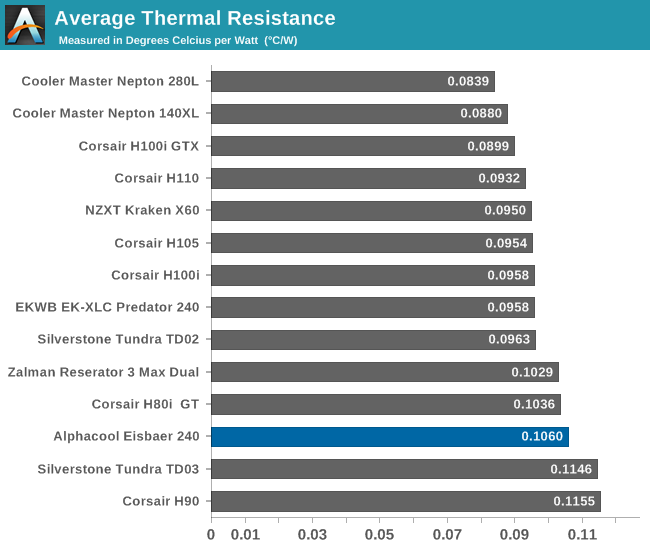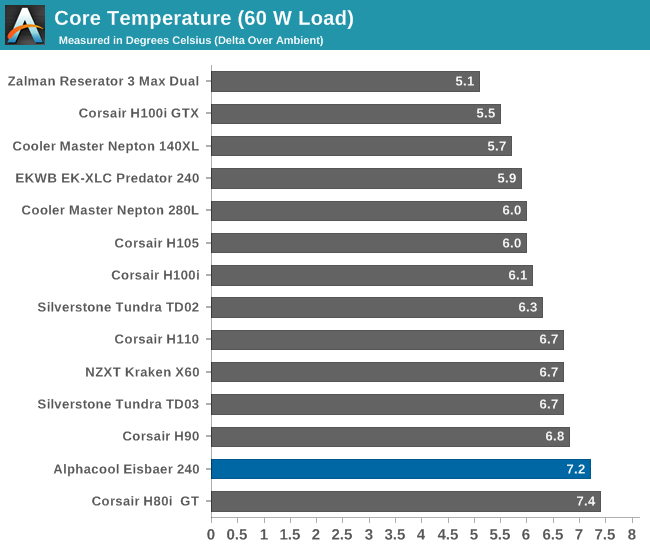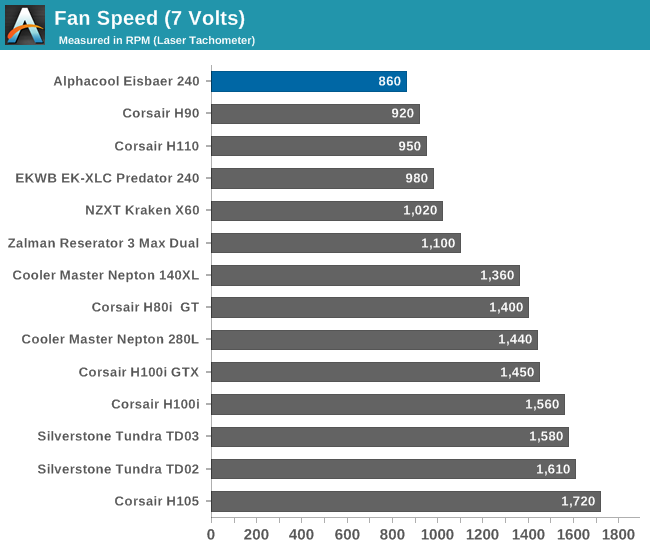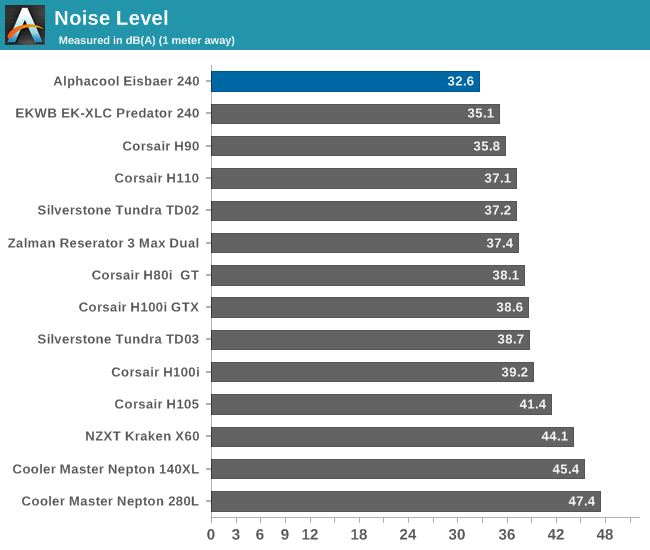The Alphacool Eisbaer 240 CPU AIO Liquid Cooler Review
by E. Fylladitakis on August 1, 2016 9:00 AM EST- Posted in
- Cases/Cooling/PSUs
- AIO
- Water Cooling
- Cooler
- Alphacool
Testing Results, Low Fan Speed (7 Volts)
The quiet fans of the Eisbaer 240 have their speed greatly reduced with an input voltage of 7 Volts, down to just 810 RPM. These fans can hardly generate any pressure at such a low speed so, naturally, the thermal performance of the Eisbaer 240 is now reduced significantly. With the average thermal performance reduced down to 0.106 °C/W, the Eisbaer 240 is now outperformed by every dual 120 mm AIO cooler that we have tested to this date.


| Core Temperature, Constant Thermal Load (Low Fan Speed) |
Nevertheless, the average thermal resistance of 0.106 °C/W is not actually bad considering that the Eisbaer 240 is virtually noiseless under these operating conditions. Our instruments recorded just 32.6 dB(A) from a distance of one meter, only 2.2 dB(A) higher than our floor noise level and a figure that it is not easily discernible by human ears inside a normal room. It is possible to discern low humming noises only from a distance of a few centimeters away from the fans and/or the pump.












69 Comments
View All Comments
ikjadoon - Tuesday, August 2, 2016 - link
You're behind. :( Already a 120mm rad with 2 fans is both 5C cooler and 0.1dB quieter than your Noctua NH-U14S.http://www.hardocp.com/article/2016/02/11/arctic_c...
FWIW, I also have a NH-U14S. Noctua buddies! :D
ikjadoon - Tuesday, August 2, 2016 - link
Nope. You are stuck in 2014. :( Gen5 Asetek is very good.5C cooler than the NH-U14S and 0.1db quieter. Maybe has other flaws...but it's not noise!
ikjadoon - Tuesday, August 2, 2016 - link
Forgot the damn link:http://www.hardocp.com/article/2016/02/11/arctic_c...
ikjadoon - Monday, August 1, 2016 - link
LOL. Using water-cooling on a CPU? You all gobbled up the marketing; you still believe in in 1990s ATX case design.GPUs need the water, not the CPU. 250W+ on load, using 9cm fans? Average load temps in the 70s with overclocking and overvoltage? Right, yes, put the water cooler on the CPU. :p
Abandon ATX cooling assumptions; it was meant for cooling Pentium 4's and 3.5" spindle disks.
wylie102 - Monday, August 29, 2016 - link
From what I've read you are right about this. My question would be - given that air CPU coolers vent/radiate their hot air into the case, as do graphics cards (open air designs at least) would it not be beneficial to have an AIO liquid cooler drawing in air from the case (it being warm shouldn't affect the CPU cooling too much as like you said, most units are more than capable) and venting it out of the case?Would this not provide a benefit to the temp of the case and therefore the cooling abilities of the graphics card (particularly if running SLI)? And doesn't it make sense to have the CPU do this given that cooling options are much more widely available for them and at less of a premium than GPU water cooling?
Hxx - Monday, August 1, 2016 - link
AIO coolers are still very much needed these days especially in a smaller form factor where air flow is not as great as in a larger case. I personally think that air coolers have reached their EOL. There is no need for a big chunk of metal to sit on top of your motherboard especially when nowadays you can buy an excellent AIO that is reasonably priced, quiet, cools better, and looks aesthetically more pleasing, and its painless to install.there used to be a time when AIOs used to be so much more money, kind of like how it is now if you want to jump into a custom loop. There is a price to performance ratio that needs to be addressed. But as far as closed loops, some of them are almost just as inexpensive as an air cooler and providing much more benefits.
retrospooty - Monday, August 1, 2016 - link
I dont think so... When talking about building a new system, we are talking Intel Skylake CPU. Anything running a Skylake is already cool as hell. There are some great small form factor cases and premade systems, as small as Lenovo Tiny Desktop that are running quad core i5 and i7 desktop processors. They are a little over 1 inch thick and dont even get hot. You would only need it if you had both a really thin/small case AND you were significantly overclocking it... Now if you bought a good enough motherboard to significantly overclock it, what case are you getting that is too small to fit a decent air cooler, but big enough where it can still fit a decent power supply that can handle significant overclocking and even a small AIO water cooler? Where is the radiator in this setup? Is it outside the case?ikjadoon - Tuesday, August 2, 2016 - link
...there are strong ITX overclocking motherboards. You don't need 1kW to OC; even SFX PSUs are in the 700W range, more than enough for dual-GPU OC + 8-core CPU OC.retrospooty - Tuesday, August 2, 2016 - link
I get that, but still what is the point? If you are overclokcing to that level, you probably arent using a tiny case. If you are, that fine, but again I ask - Where is the radiator in this setup? Is it outside the case?Sushisamurai - Sunday, August 7, 2016 - link
I'm running a tri-fire and 6core CPU. I should have a custom loop on the GPU's, but... whatever, they're too old now to drop that much money into them. Full load is close to 1000W - it's potentially a lot of heat, but radiator's are in the case, with a lot of airflow. GPU's hit 80 degrees and CPU's @60.